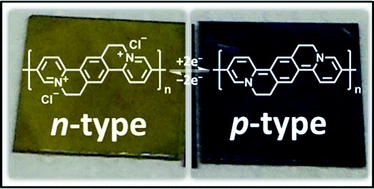Solution-processed organic thermoelectric materials exhibiting doping-concentration-dependent polarity†
Abstract
Recent progress in conducting polymer-based organic thermoelectric generators (OTEGs) has resulted in high performance due to high Seebeck coefficient, high electrical conductivity (σ), and low thermal conductivity obtained by chemically controlling the materials's redox levels. In addition to improving the properties of individual OTEGs to obtain high performance, the development of solution processes for the fabrication of OTEG modules is necessary to realize large thermoelectric voltage and low-cost mass production. However, the scarcity of good candidates for soluble organic n-type materials limits the use of π-leg module structures consisting of complementary elements of p- and n-type materials because of unbalanced transport coefficients that lead to power losses. In particular, the extremely low σ of n-type materials compared with that of p-type materials is a serious challenge. In this study, poly(pyridinium phenylene) (P(PymPh)) was tested as an n-type semiconductor in solution-processed OTEGs, and the carrier density was controlled by a solution-based chemical doping process using the dopant sodium naphthalenide, a well-known reductant. The electronic structures and doping mechanism of P(PymPh) were explored based on the changes in UV-Vis-IR absorption, ultraviolet photoelectron, and X-ray photoelectron spectra. By controlling the dopant concentration, we demonstrate a maximum n-type power factor of 0.81 μW m−1 K−2 with high σ, and at higher doping concentrations, a switch from n-type to p-type TE operation. This is one of the first cases of a switch in polarity just by increasing the concentration of the reductant and may open a new route for simplified fabrication of complementary organic layers.


 Please wait while we load your content...
Please wait while we load your content...